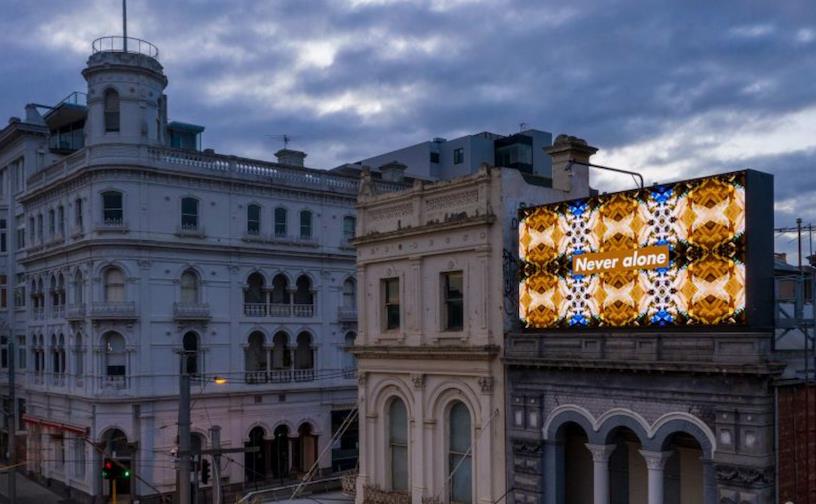If you can’t connect with art audiences inside, then do it outside, is the new mantra!
With visitor numbers restricted and many galleries, museums and theatres closed, the experience of art has taken to the streets during COVID-19.
Around the world, artists have taken to large communal spaces to engage directly in our planetary struggle with billboard art projects, metro lights and transformative interventions to illustrate the human experience of life under unique rules. This has allowed communities to still be creatively engaged and keep the spirits up, while also providing an outlet for artists to find connection in times of social distancing.
Here are 10 projects that pipped our radar:
1. APA takes to Melbourne streets in lockdown
As Melbourne residents were caught in a 5km radius under COVID lockdown, many were lucky to still discover art installations on their daily walk, boosting morale.
Arts Project Australia (APA) partnered with Civic Outdoor to roll out a series of large-scale billboard art installations across Melbourne suburbs.
APA Director Sue Roff said: ‘The impacts of COVID-19 has dictated our studio and gallery close over the last six months; this partnership provides our gallery with a high-profile way to exhibit art across Melbourne.’
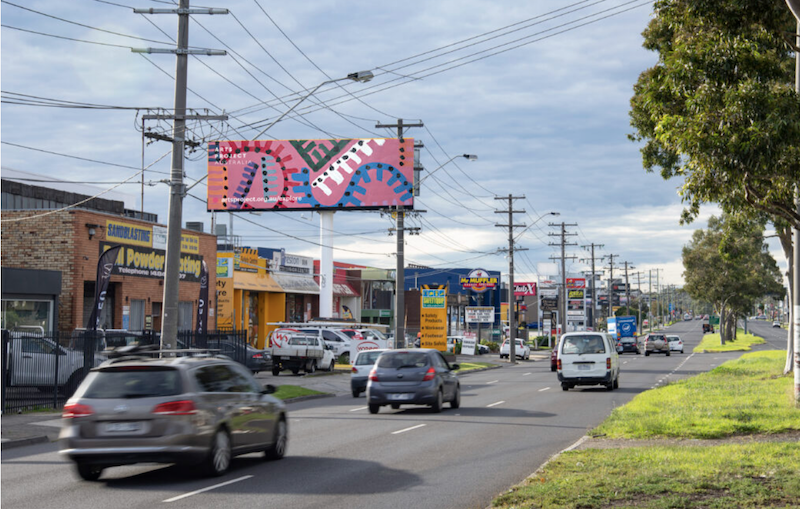
Courtesy Arts Project Australia and Civic Outdoor.
Billboard art installations were presented in Preston, Kilsyth, Collingwood, Sunshine, Wantirna, Bayswater, Bentleigh and Bundoora during September, and are currently moving to other locations, where they will be shown until the end of December 2020.
Artists include Julian Martin, Mark Smith, Eden Menta, Monica Lazzari, Anthony Romagnano, Samantha Ashdown, John Bates, Robin Warren, Warren O’Brien, Lachlan Turk, Boris Cipusev, Miles Howard Wilks and Jordan Dymke.
2. street furniture TURNED into galleries
In September, oOh!media paired up with the contemporary commercial gallery STATION for a campaign to showcase works by Australian artists across its classic street furniture and rail sites.
Also exclusive to Melbourne, and at a time when the city was caught in lockdown, the campaign aimed at highlighting meaningful art that reflected on the current conditions, reaching the city’s commuters and essential workers at multiple points throughout the day.
Artworks created for the campaign focused on COVID, and the artists’ interpretations of emotions felt during lockdown, and some of the positives to come out of isolation.
The artists were: Adam Lee, Dane Lovett, David Griggs, Jason Phu, Jonny Niesche, and Nell.

Jonny Niesche. Image courtesy oO!media and the artist.
‘All the works from these talented artists were created during the height of lockdown, and echo the range of emotions felt by Victorians right now.’
‘…we’re giving artists a canvas, effectively turning Melbourne’s streets into a gallery,’ Ackland continued. ‘If we can encourage some moments of quiet reflection from the chaos of lockdown, then it’s worth it.’
Samantha Barrow, STATION’s Gallery Director, added: ‘From the outset we have pursued new avenues to continue presenting exhibitions to audiences and supporting our artists in this challenging time.
‘Most of these initiatives have been focused in the digital sphere, but we strongly believe that the virtual cannot replace the experience of a physical encounter.’
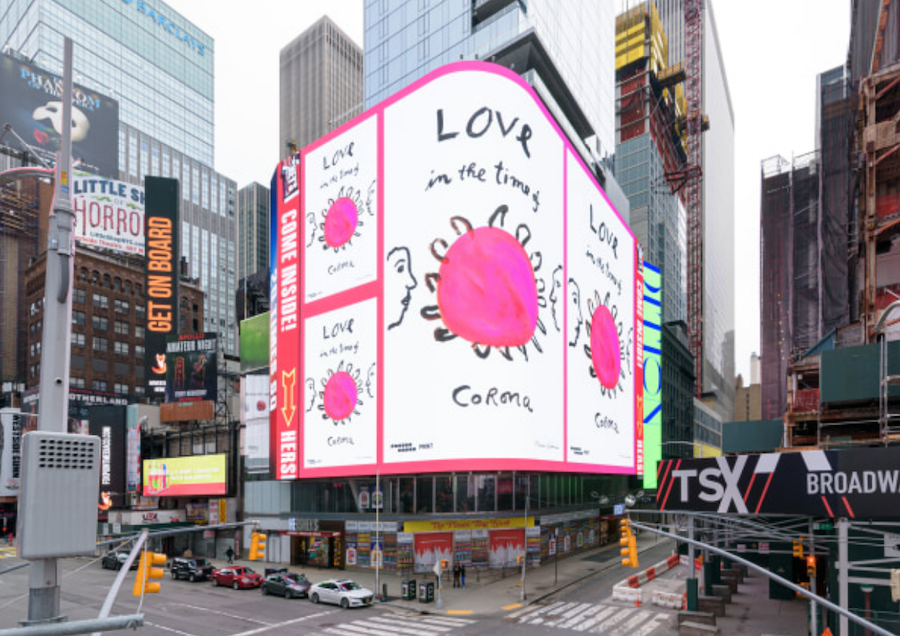
Maira Kalman. Photo: Ian Douglas/courtesy Poster House and Times Square Arts
3. Times Square becomes a message of hope
New York’s Times Square is famed for its billboards and lights. In April, some 1,800 digital billboards across the Square and all five boroughs of the city were illuminated with public artworks related to the COVID-19 crisis.
The project was a collaboration between Poster House, Times Square Arts, PRINT, and For Freedoms. Twenty-two prominent artists and designers contributed work – from Milton Glaser who designed the “I ❤ New York” logo, artist and illustrator Maira Kalman, Matt Dorfman who art directs the New York Times Book Review, to Paul Sahre and Debbie Millman.
The tech-based campaign uses the city’s abundant ad space (all of which was donated) to share messages of solidarity, remind people of best practices, and send thanks to the healthcare workers risking their lives on the frontlines.
Billboard owners ‘really wanted to contribute their assets to something beneficial to the city,’ Poster House Director Julia Knight said.
Though everyone, ideally, is staying indoors, the participating organisations hope that works will be seen by the public during brief essential errand runs — or on social media — not to mention critical workers who pass through Times Square daily.
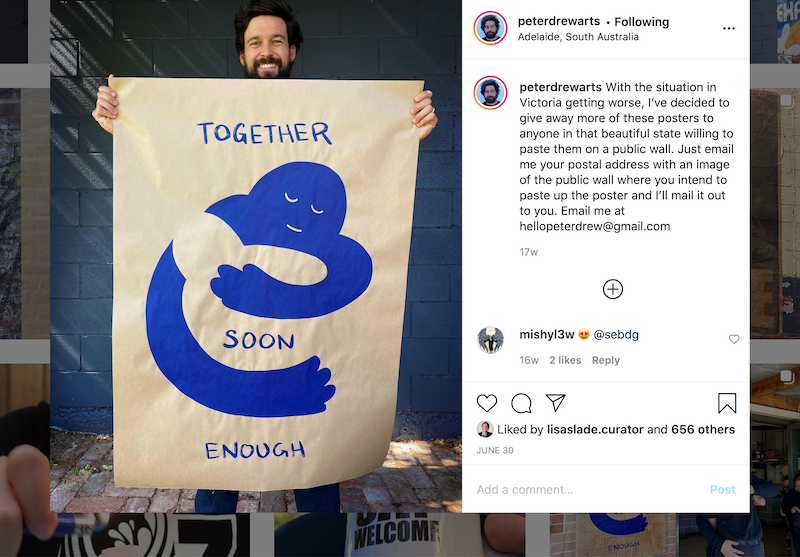
Courtesy @peterdrewarts
4. Offering a simple hug
The comment most often heard over the past six months is that people are missing physical connection and affection with others.
Adelaide-based street artist Peter Drew – known for his political paste ups that question that question identity, racism and social mores – has responded to the current climate. Simply titled the Hugs poster, Drew says his latest project comments on the irony of having to stay apart from our loved ones to protect them.
Shared nationally, punters can get their copy by simply reaching out to Drew. Between mid-April and mid-August, he sent almost 400 copies all over Australia, as well as a few dozen overseas; about 100 went to Victoria. They’re also available via his website.
A drawing of a figure hugging another figure, and bearing the text ‘Together Soon Enough’, it encourages a collective optimism. Drew hopes that the pandemic might ultimately leave us with an increased sense of unity within the community.
‘I think everyone is going through the same thing, and that’s discovering how much we need each other and how that closeness is something we long for when it’s taken away,’ Drew told CityMag. ‘I was looking at social media and there were people still running on the old paradigm of political bickering – it’s not the time for that.’
Along with Hugs, Drew has also revisited #PixelFace, a design from ten years ago which is also finding its way into a COVID-city landscape.
And on The ArtsHubbub this month, Peter Drew talks about how it was a trip to Glasgow that got him started with his politically toned paste ups that connect with people on the streets.
5. Focusing on women
While this project was conceived of, and initiated pre-COVID, it continued to gain traction nationally during the pandemic.
The Know My Name National Art Event was presented in partnership between the National Gallery of Australia, regional venues, and oOh!media from late February through April.
1,500 static and digital locations across metro and regional Australia featured images of works by Australian women artists from the collection, reaching more than twelve million Australians. It is about educating the broader public about the contributions of women artists to Australian cultural life.
From large scale billboards, to bus shelters and shopping centres across the country, seventy-six works from the 1920s through to contemporary pieces were engaged by close to 80% of the Australian population.
In a similar move, Billboard Istanbul 2020 kicked off in September right in the heart of the pandemic, and is part of an international outdoors visual art project that similarly showcases the work of 115 female artists on the streets of Istanbul.
‘I have been working between Denmark and Turkey for three years,’ said project curator Fusun Eriksen. The Danish Cultural Institute is one of the collaborators – alongside Kentvizyon, a billboard company which features photographs shot by female artists from Turkey, Morocco and Nordic countries.
The two-week long exhibition ran from September through October. The brainchild of Danish visual artist Hanne Lise Thomsen, the project is about ‘raising awareness and encouraging public debates on gender issues, as well as bringing contemporary art to a wider audience of all genders and ages.’
Thomsen also curated and realised Billboard Casablanca in 2015, as well as the billboard project ‘We Are From Here in Ramallah’ in 2012, and also the citywide billboard project, ‘Women 2003’ in Copenhagen and Malmo.
The difference was this was created in very different times during the pandemic.

Nadia Odlum painting a labyrinth painting at the Wentworth Point Community Centre and Library forecourt.
6. Parramatta by foot
Parramatta by Foot is a new street art project in Western Sydney commissioned by the City of Parramatta Council with the intention of engaging artists during COVID.
Curated by Parramatta Artists’ Studios, Western Sydney-based artists Kalanjay Dhir, Leanne Tobin in collaboration with First Nations artist Jason Wing, and PAS alumni Nadia Odlum and Penelope Cain created four temporary footpath artworks in the Rosehill Ward, City of Parramatta over July and August.
I’ll meet you here again by Nadia Odlum (pictured) was a labyrinth painted in the Wentworth Point Community Centre and Library forecourt. This work is inspired by the historic labyrinth at Chartres Cathedral in France and reflects on the shifts in how people move through public spaces during COVID-19.
The project was intended to help the community stay connected while social distancing.
7. Never Alone is the message
In August, Melburnians passing by a busy intersection in St Kilda were greeted with the words ‘never alone’ emblazoned across a digital billboard (pictured top).
Surrounding those words was a vivid, tessellated pattern, made from a single image of a nankeen night heron taken by Kent Morris, a Melbourne-based artist and descendant of the Barkindji people of north-western New South Wales.
The billboard is located halfway between two significant First Nations cultural and meeting places: the Ngargee (Bunurong Corroboree) Tree and Cleve Gardens.
Morris told ABC: ‘I think we’ve seen a reframing of how we collectively perceive time; we remember the past, we have an anxious present, and there’s an uncertain future ahead of us.’ He says that moving forward, we need to think ourselves as part of a community.
Morris has received an outpouring of passionate responses to the billboard, with many people expressing that the artwork has given them ‘a sense of connection.’
Since the pandemic began, the Port Phillip Bay resident has seen local bodies of water become cleaner and clearer, and on night walks has begun spotting the nankeen night heron.
These are the reflections that animate Morris’s billboard, which was a commission from the Australian Centre for Contemporary Art (ACCA) and the first in a series of projects the Melbourne gallery is launching in the lead-up to its 2021 exhibition, Who’s Afraid of Public Space?
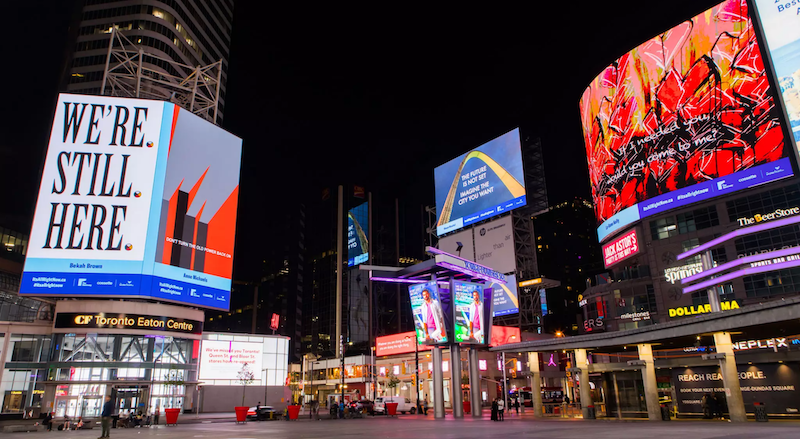
‘We’re still here’. Image courtesy the artist and The Bentway, Toronto.
8. Billboards for words – not images
Like Australia, Istanbul and New York, Toronto has also repurposed its billboards during COVID. As no one is looking at advertising in these oversaturated spaces, the desire for a more considered engagement has arisen.
It’s All Right Now, is a Toronto-wide scheme from The Bentway Conservancy, that asked 20 Toronto-based artists a the question: What words are you living by?
‘Ultimately, the project invites Torontonians into a larger collective dialogue, perhaps even catharsis,’ says The Bentway.
The text-based works included artists Ani Castillo, Tessar Lo, Anne Michaels, Quentin VerCetty, and Daniel Rotsztain – which not only graced billboards but on the side of a video truck, which drove around Toronto’s Waterfront during the month of June.

PHOTO 2020 is inviting artists during COVID to join an urban project in Fed Square. Image supplied.
9. Photo Festival does Fed Square
PHOTO 2021 International Festival of Photography will be taking over Fed Square in central Melbourne as part of the global art project Inside Out, initiated by French artist JR, and to mark the opening week of the inaugural festival in February 2021.
Inside Out is a project that seeks to give everyone a platform to speak their truth, and transforms messages of personal identity into giant works of art.
For PHOTO 2021, up to 1000 portraits will be printed as posters and pasted on Fed Square’s iconic main square.
PHOTO 2021 is inviting people to submit photos of themselves and a personal statement answering, ‘What is your truth?’. Images have been collected during COVID, and close 22 November.
‘In a time when the truth is being challenged, and newspapers are being silenced, this is a public call to arms,’ said PHOTO 2021 Artistic Director Elias Redstone. ‘The Inside Out Project gives everyone a platform to speak their truth.’
‘With isolation being felt by so many right now, particularly for Victorians, we look forward to celebrating our community in Fed Square once we can be in public together again. People will have the opportunity to see their faces presented as part of a city and state-wide celebration of photography,’ Redstone added.
The Inside Out project has travelled from Ecuador to Nepal, and from Mexico to Palestine, inspiring group actions on varied themes such as hope, diversity, gender-based violence, climate change.
Each Inside Out group action around the world is documented, archived and exhibited online. Over 260,000 people have participated in 129 countries to date, and PHOTO 2021’s group action will be the largest scale project in Australia, with support from the City of Melbourne.
The inaugural PHOTO 2021 International Festival of Photography has announced its new dates, taking over Melbourne and regional Victoria from 18 February – 7 March 2021. The Festival was rescheduled in response to the COVID-19 pandemic. For more information about PHOTO 2021 visit photo.org.au
